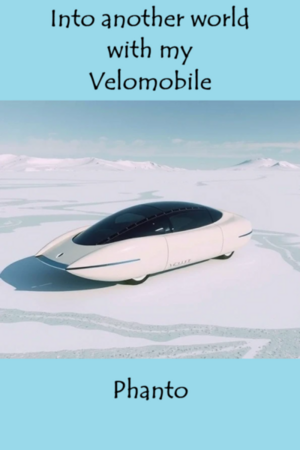Chapter 8:
Nerd stuff (skip if it bores you, but only at your own risk!)
Into another world with my velomobile
I suppose ælves have much better eyesight than humans. Illyára's was maybe even magically enhanced, because I didn’t see a thing. Unfortunately I’d left my binoculars down in the cave, so I had not the opportunity of checking her statement.
“You may not spot them yet, but they are there. Far, far away behind the caldera rim.” she informed me.
“How can you see them?” I asked, flabbergasted. The rim was itself quite far away and looked to me more like a line on the horizon. She smiled and settled her strange bright eyes on me.
“Magic!” she simply answered and pointed towards them.
“They seem to be still gathering, but could be here in about half a candle, maybe shorter.”
I assumed that meant about half an hour.
“Can I be of any help?” I asked, despite having been rejected earlier.
She shook her head.
“No. The best you can do is to take cover and protect your vehicle. Maybe we’ll need it nonetheless.”
With that she grabbed a boulder and began to mold it like clay into a sleek elongated shape with a pointed head. It was an eerie sight I watched in fascination, as her hands kneaded and shaped the hard, unyielding rock. A few seconds were enough to produce a deadly projectile about the length of a forearm. Without pause she picked the next rock up and had him reshaped in no time, and then another and another one. She worked fast and concentrated, my presence seemingly forgotten. I took the hint and returned to the lava cave and my Munchie.
There I finally folded the solar roof, so I could set off at any time. Right now the batteries were unfortunately just at 60% and I didn’t know when I could charge them again under the threat of the dragons. Normally I would search for a small stream or a well to wash the dishes, but I had to bunker down, so that was out of the question.
I had a lot of information to process.
It seemed that the land Illyára called Skîbæria was similar to earth's Antarctica, but instead in the far south it was in the far north and not as isolated, as it bordered directly on other landscapes. I wondered when I could have a look at a map, so I may get a better understanding of the local (maybe even global) geography. Or better: Liyúrography, to be precise!
Our journey to the south over the vast icecap would certainly be a very dangerous one. The only bright side was the shining sun that told me that it must be summer (or at least late spring or early autumn). At this high latitude the sun doesn’t set under the horizon in summer - if the axis tilt of Liyúra was similar to earth's. But why not? The similarities already were astonishing! Despite the higher gravity and the thicker air, the latter was at least breathable. I didn’t faint or die from carbon dioxide overdose or too high concentrations of toxic gases like sulfur dioxide, chlorine or ammonia. Many planets in our solar system already have much more exotic (that means deadlier) settings than Liyúra!
Despite being in the warmer half of the year I prepared to expect temperatures of down to -30°C and freezing winds on the open ice sheet that would lower the temperature even more. I was pretty sure the batteries of my Munchie wouldn’t like that! Not to mention me or the girls of course! But I was quite sure that this problem could easily be solved with magic.
And then there was the question of supplies. I was willing to share, but how long would we really last if we had to cover thousands of miles on ice?
I calculated: With an iceboat like the one Al’Reeza attempted to build, we could reach an average speed of maybe 50 miles per hour. Assuming that it was possible to magically direct the wind into the optimal angle for the sail, and a smooth, unbroken ice surface. With this speed we could cover 1.200 miles in 24 hours and reach the Askæliaen Mountains in two or three days (correction: earth days! I didn’t know the length of liyúrean days yet…).
But for that scenario everything would have to go as smoothly as possible, something we couldn’t count on. Still, I was happy that I bought a surplus of supplies to be as independent as possible in the Icelandic highlands. Heck, it was less than a few hours I wasn’t on earth anymore and yet it already seemed so distant…
Back to the topic! Since I bought enough food to sustain one person for about two weeks it seemed possible that it could sustain me and the three girls for three to four days (provided their appetite didn’t deviate too much from mine of course). For everything beyond that we had to find another food supply. Well, Lily already was taking care of that.
Still no sign of the dragons. No roars, shrieks, explosions or other battle noises.
I tried to read in my ebook-reader, but couldn’t concentrate.
So to pass the time, I tried a little experiment:
With the help of my measuring tape I hold a little chunk of lava as exactly as possible two meters above the ground. When I let it fall, I measured the time the lava stone needed to hit the ground with the timer on my smartphone. I had to do it a few times to get a solid mean time, since there were of course slight deviations between the drops.
In the end I got an average time of 0,57 seconds. Now it was easy to calculate the acceleration of the stone via the formula two times the distance divided by time squared (4/0,57^2). The result was 12,3115 meters per second squared. That was (approximately) the gravitational acceleration on Liyúra. Slightly higher than earth's 9,81 meters per second squared.
I sighed. I felt that from the very first moment!
But now the real fun just started! I tried to calculate Liyúra’s radius and diameter to get a feeling for its size. Unfortunately I didn’t know its body mass, so in the end I just got a few approximations with the formula r = √(GM/g), where g was Liyúra's gravity pull (12,3115 m/s^2), M was the mass of Liyúra in kilograms, and G was the gravitational constant (6,674x10-11 N). Fortunately I could look up earth's mass in my ebook reader to have a comparison: 5,9736^24 kg which I could use as a reference.
I got following results:
If Liyúra had one earth mass, it would measure 7.113,2 miles in diameter. If Liyúra had 1,5 earth masses, its diameter would increase to 8.712 miles. With two earth masses it’d have a diameter of 10.059,6 miles.
For reference: Earth has a diameter of 7.926 miles.
Math really is a beautiful thing! Every result leads to new results and these continuously to new ones, like branches on a tree. I felt a familiar thrill: the power of deduction; finding essential facts from small indices through knowledge and math!
Because now I could calculate possible volumes, surface areas and densities of Liyúra and compare them to examples from real known planets.
For example: If Liyúra possessed just one earth mass, its volume would be around 188 billion cubic miles with a surface area of nearly 159 million square miles, and a density of 7,74 g/cm3.
If Liyúra had 1,5 earth masses, its volume would increase to 346 billion cubic miles, a surface area of 238 million square miles, but its average density would drop to 6,32 g/cm3.
At two earth masses Liyúra would have a volume of 533 billion cubic miles, a surface area of 318 million square miles, and a density of 5,47 g/cm3.
Compare that to earth’s volume of 260 billion cubic miles, its surface area of 197 million square miles and its density of 5,51 g/cm3.
What can I say? Math is really beautiful!
You see this, big brother?! That ‘good-for-nothing thing’ is good for something after all!
Unfortunately a distant roar reminded me that real life danger was near!




Please sign in to leave a comment.